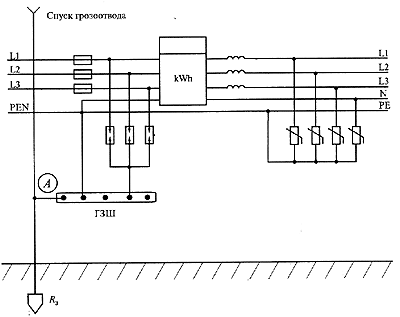13. Principles of Execution of Overvoltage Protection
13.1. GENERAL PROVISIONS
The regulatory framework for lightning and switching overvoltage protection systems for low voltage power supply networks has not been sufficiently developed to date.
The PUE (7th ed., Paragraph 7.1.22) contains the following requirement:
"... In the case of air entry, surge arresters shall be installed."
The Technical Committee of the International Electrotechnical Commission - TC 37 has developed standards for protection against lightning storms and switching surges - IEC 61647-1,2,3,4, IEC 61643-1,2, IEC 61644-1,2.
On the basis of IEC 61643-1 (1998-02), "Overvoltage protection devices for low-voltage power distribution systems - Operational requirements and test methods" was developed, in particular, the German standard VDE 0675 P.6. "Surge arresters and overvoltage protection devices for AC 100-1000 V networks".
In Russia, lightning protection systems are regulated by the "Instruction for the installation of lightning protection of buildings and structures (RD 34.21.122-87)".
Lightning protection is one of the sections of the complex of tasks to ensure electromagnetic compatibility. Currently, the overvoltage protection zone concept (IEC 1024) is generally accepted.
There is a difference between external and internal lightning protection.
External lightning protection is designed to protect buildings and other objects with direct lightning strikes. This protection is one or several low-resistance and low-inductance lightning current paths to earth (a lightning rod consisting of a current collector, a current collector and a grounding conductor). External lightning protection is classical and is performed in accordance with applicable regulations.
Internal lightning protection protects electrical installations and electronic devices inside buildings from partial lightning currents, from switching, lightning overvoltages and increasing the potential in the earthing system. In addition, the internal lightning protection provides protection against the effects caused by lightning strikes, electromagnetic fields. For internal lightning protection, the main condition is the availability of an effective grounding system. Internal lightning protection has acquired significance only in recent years due to the wide spread of microelectronics.
The boundaries of the echeloned protective zones in the building are formed by external lightning protection devices, walls of buildings (metal facades, reinforcement of bearing walls, etc.), internal shielded rooms, measuring chambers, instrument cases, etc.
In Fig. 13.1 shows the power scheme of an electrical installation with a stepped overvoltage protection system. At the main input, after a group of fuses, spark gaps are connected between each phase conductor and the main earthing bar. When surges are applied to the wires of the network, or when the potential of point A rises during a direct lightning strike, the arrester triggers and passes a charge to the ground.
When the lightning strikes, the potential of point A with respect to the remote earthing switch, for example, the grounding electrode of the power supply transformer, can reach a million volts. However, the voltage between the phases of the mains and the main earthing bus will not exceed the value of the voltage of the spark gaps. This means that all internal wiring experiences the same potential increase.

Fig. 13.1. Scheme of power supply for a power plant with a stepped overvoltage protection system
It is also possible to assume that with a ratio of the earthing resistor to the network wires of 1:10, only 10% of the lightning current enters the distribution network of the electrical installation.
Along with classical arresters in internal lightning protection, special surge arresters (ARVs) are used, consisting of a parallel-connected spark gap and varistor. The varistor limits the often occurring overvoltages caused by distant lightning strikes, the spark gap is triggered by a direct lightning strike, if the high varistor voltage remains due to high currents on the varistor. If necessary, in areas with high thunderstorm activity, the remaining overvoltages in subsequent zones are reduced by additionally included varistor or combined arresters with different parameters set at the boundaries of the zones. In this case, to isolate the protection stages, special ones are used that are connected in series to the inductor line.
Thanks to rationally separated protection, it is possible, as in high voltage networks, to achieve the required coordination of insulation.
In Russian regulatory documents, instructions on the use of OPN are contained in the "Interim Guidelines on the Use of RCDs in Building Electrical Installations" (IP from 29.04.97 No. 42-6 / 9-ET). In Sec. 6 "Guidelines for the use of RCDs for individual construction sites" in paragraph 6.3 indicate: "When selecting the power supply scheme, distribution boards and the RCD types proper, special attention should be paid to the necessity of installing overvoltage arresters (arresters) during air entry." There is also a diagram of the power supply of the cottage where the main input shows the connection of surge arresters from phase and neutral conductors to the PE bus.


Comments
When commenting on, remember that the content and tone of your message can hurt the feelings of real people, show respect and tolerance to your interlocutors even if you do not share their opinion, your behavior in the conditions of freedom of expression and anonymity provided by the Internet, changes Not only virtual, but also the real world. All comments are hidden from the index, spam is controlled.